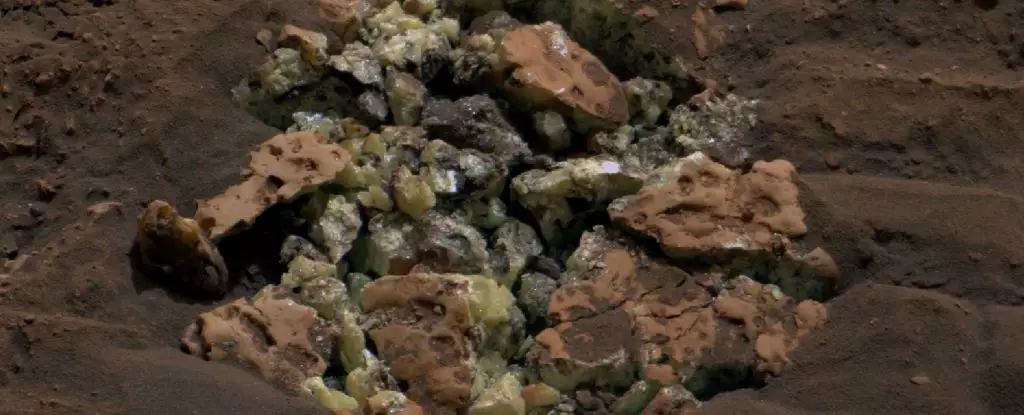In a remarkable serendipitous event, NASA’s Curiosity rover uncovered a striking discovery on the Martian landscape—pure elemental sulfur. The rover, which weighs approximately 899 kilograms (1,982 pounds), rolled over an inconspicuous rock in the Gediz Vallis Channel in May, inadvertently cracking it open to reveal vibrant yellow crystals of sulfur. This discovery marks the first known occurrence of sulfur in its pure elemental form on Mars, a significant milestone in planetary geology. While sulfates are commonly found on the Martian surface, the revelation of pure sulfur prompts numerous questions regarding the geological processes that led to its formation.
Discovery of such unexpected minerals can offer a wealth of insights into Mars’ geological past. Sulfur, an essential element for life as we know it, typically appears in the form of sulfates, which are mineral compounds formed in aqueous environments. Through the evaporation of water, these sulfates remain as evidence of the planet’s wet history. However, pure sulfur crystallizes under conditions that are not believed to exist in the vicinity where Curiosity operated. This invites researchers to reconsider the geological narrative of the region and the processes at play.
Curiosity project scientist Ashwin Vasavada poignantly likened the finding to discovering an oasis in a desert. The analogy highlights the unexpected nature of this discovery, challenging longstanding assumptions about the composition of Martian rocks. The presence of similar-looking rocks littered throughout Gediz Vallis raises intriguing possibilities: could there be abundant deposits of pure sulfur waiting to be unearthed? The scientific community now faces the task of explaining not only how such deposits could exist, but also what this means for our understanding of Mars’ environmental history.
The context of this discovery extends beyond mere curiosity. Understanding the geological processes that produced pure sulfur could provide clues about Mars’ ancient climate and any potential for habitability. While signs of past water flow are well-documented, the presence of sulfur in its elemental form suggests that additional, perhaps unexpected, conditions were favorable at some point in the planet’s history. This underlines how much remains unknown about Mars, where the geological history is as complex and layered as the planet itself.
In the science of astrobiology, the implications of this discovery stretch further still. Sulfur plays a crucial role in the formation of amino acids, the building blocks of proteins essential for life. Although previous findings of sulfates on Mars hinted at the planet’s capacity to support life, this new discovery sparks a lively debate about the potential for biological or pre-biological processes to have occurred in Mars’ distant past.
Curiosity continues its journey through the Gediz Vallis Channel—a region characterized by its ancient water tens of billions of years ago. As the rover drills deeper into various rock formations and collects additional samples, the hope is to paint a clearer picture of the red planet’s history.
Additional research will focus on modeling Mars’ geological evolution to explain the sulfur’s sudden appearance in its elemental form. The rover’s analytical instruments are instrumental, yet they are inherently limited to the areas Curiosity can physically explore. The Odyssey of this rover serves as a reminder of the intricate interplay between chance and determination within the realm of planetary research.
As Curiosity continues its exploration, the discoveries made today could alter our understanding of Mars, potentially reigniting hopes of its habitability. The yellow treasure recently unearthed is not merely a statistic in a scientific discovery log but a key that could unlock a multitude of mysteries about the Martian landscape. The anticipation for further revelations remains high, as researchers and enthusiasts alike await the next installment of this ongoing Martian saga.

